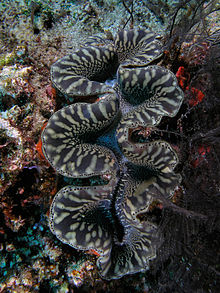Giant clam
| Giant clam | |
|---|---|
 |
|
| A live individual of Tridacna gigas, in situ with only the edges of the mantle showing | |
| Scientific classification | |
| Kingdom: | Animalia |
| Phylum: | Mollusca |
| Class: | Bivalvia |
| Subclass: | Heterodonta |
| Infraclass: | Euheterodonta |
| Order: | Veneroida |
| Family: | Cardiidae |
| Subfamily: | Tridacninae |
| Genus: | Tridacna |
| Subgenus: | Tridacna (Tridacna) |
| Species: | T. gigas |
| Binomial name | |
|
Tridacna (Tridacna) gigas (Linnaeus, 1758) |
|
| Synonyms | |
|
Chama gigantea Perry, 1811 |
|
Chama gigantea Perry, 1811
The giant clam (Tridacna gigas), known as pā’ua in Cook Islands Māori, is a clam that is the largest living bivalve mollusk.
Tridacna gigas is one of the most endangered clam species. Antonio Pigafetta documented these in his journal as early as 1521. One of a number of large clam species native to the shallow coral reefs of the South Pacific and Indian oceans, they can weigh more than 200 kilograms (440 lb), measure as much as 120 cm (47 in) across, and have an average lifespan in the wild of over 100 years. They are also found off the shores of the Philippines, where they are called "taklobo", and in the South China Sea in the coral reefs of Sabah (Malaysian Borneo). Tridacna gigas lives in flat coral sand or broken coral and can be found at depths of as much as 20 m (66 ft). Its range covers the Indo-Pacific, but populations are diminishing quickly and the giant clam has become extinct in many areas where it was once common. Tridacna maxima has the largest geographical distribution among giant clam species; it can be found off high- or low-elevation islands, in lagoons or fringing reefs. Its rapid growth rate is likely due to its ability to cultivate algae in its body tissue.
Although larval clams are planktonic, they become sessile in adulthood. The creature's mantle tissues act as a habitat for the symbiotic single-celled dinoflagellate algae (zooxanthellae) from which the adult clams get most of their nutrition. By day, the clam opens its shell and extends its mantle tissue so that the algae receive the sunlight they need to photosynthesize.
...
Wikipedia

